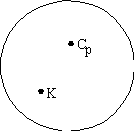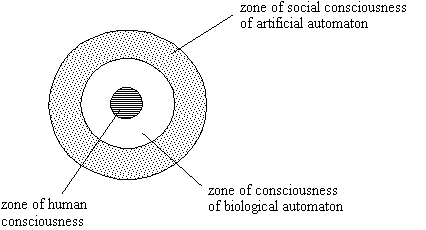There is one property in man which society
is devoid of: self-awareness. This is nowadays largely
accepted and, according to experimental evidence, any item of
information can be used in self-aware or not-self-aware zones.
Information may be not-aware and non-conscious, it may be bound
to the consciousness of an automaton or it may be aware.
These three types may be also found in man, but outside man we
can only find the first two types. In the literature on information
technology, any type of information, understood as knowledge,
presupposes a self-aware subject:
"Information is alwaysconnected to a real or imaginary
person, who is the referenceperson, or, otherwise stated, information
is always the informationof a
person"11.
Bo Sundgren introduces a consciousness function
for some information K with respect to a person
P at timet:
C(K,P,t) = values from 0 to 1
If Rp(t)denotes the reference frame of
the person, consisting ofconcepts, definitions, knowledge, the laws of logic
a.s.o., andthe information K is outside the reference frame
at time t, thenthe consciousness function assumes zero value,
Bo Sundgren envisagesa consciousness center, where
C = 1 and with respect to which"we can think about the
reference frame of a person as agravity center about its consciousness center,
Cp(Fig. 5). The shorter the distance between some
informationK and C, the higher the degree of
consciousness C(K,P,t)"
12.

Fig. 5
Extending these ideas on the consciousness
of automata, we could resort to the diagram shown in Fig. 6,
where the self awareness zone is supplemented in man by a zone
of the consciousness of his biological automaton, which is in
turn supplemented by a social consciousness of artificial automata.

Fig. 6
In fact, the social consciousness which would
be stored in a social informational system would be a general
framework for human consciousness and self-awareness (Fig. 7).
The artificial automaton in Fig. 6 may be a continuation of
the human consciousness, whereas the general social automaton
in Fig. 7 is not a mere continuation and could work as an environment
which, unless it is subject to a continual regeneration, can cause
a change of the ensemble into an automaton, and so society might
relinquish any philosophical future. The above statements illustrate
the need for a timely correction of our historical trajectory,
for a philosophical compensation in society together with a subordination
of artificial automata to the human needs and aspirations.
If the human society is willing to regard
the individual with due attention, then it needs energy
and automata but also a spiritual life. Industrial robots
are used in machine-building plants as automata possessing sufficient
artificial intelligence to perform operations that are not stepwise,
accurately prescribed. Instead, they are used only to serve an
aim, as is, for instance, the strict coupling of two sub-units
which are randomly placed on the manufacturing band. It is the
robot which places them suitably by itself and then assembles
them.
History, Philosophical Futureand Science
34







